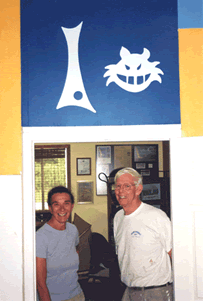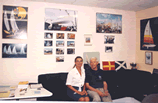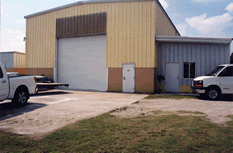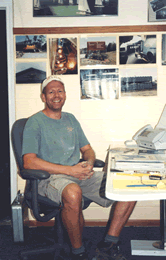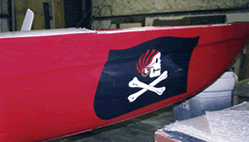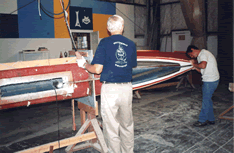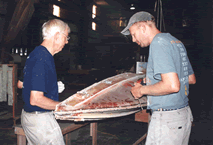
| |
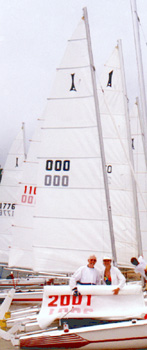
Custom Fiberglass International (CFI) has over 34 years experience in custom fiberglass fabrication for industrial and other uses. In addition to custom fabrication, CFI manufactures catamaran sailboats. The Story of International Fiberglassby Jim VickersPondering the plight of artists in a pickle -- a Van Gogh voluntarily crossing the bar after hundreds of paintings produce a single sale; a Gauguin expiring of syphilis in pagan poverty, his work rejected -- moistens the eyes of all sensitive mortals. Yet the tragedy of the popularly unrecognized but talented artist is the accepted common fate of the skilled craftsman, one of whom is Frank Meldau, who exercises his talent at IFG (International Fiberglass) on South Miami Boulevard between the Research Triangle Park and Durham. Those in the fiberglass trade, however, know Frank well, as Carrboro designer Diane Gillis discovered two years ago when she was looking for someone to embody her plans for the Airport-Playport in Terminal A at the Raleigh-Durham International Airport and followed up on references to IFG. "It was a pretty loose situation," Diane says of the bedroom-size playarea airplane mock-up. "Frank had to really put a lot into it to make the curved fuselage and wings meet the space because there was really no way that I could dimension it on a drawing. It was a very custom job." Wallace Kuralt, the proprietor of the Intimate Bookshop chain in Chapel Hill, Raleigh, Winston Salem, and elsewhere, has engaged Frank often to execute his personal designs---oversized books, computer stands, a copper-toned inside awning for his Charlotte store. "He's a remarkable craftsman," Wallace asserts. "He is great doing whatever. Just the touch and feel of everything he does is so right." To create an object from fiberglass, Frank first creates a "plug", a true-size rendition of the final product, from which he takes a mold. "Almost any material can be used for the plug," Frank explains, "just as long as I can get the shape." For the Playport, urethane, plastic and random odds and ends went into the plug.
A First Encounter with the Catamaran From his grammar school days in Raleigh, sailing had been his favorite sport, appropriate since he had been born in August 1931 aboard a sailing yacht off Charleston, SC. Although the bulky Hawaiian double-hull was poorly designed, its speed led Frank to think, "What is true for that large boat can be true for a smaller boat---a 16-foot or a 20-foot boat would do the same thing."
The Model of UNC He originally planned to build a 13-by-15-foot model capturing campus geography with 4000 contour lines and depicting buildings with crude, solidly painted blocks, but when administrators saw a sample section, they insisted that the buildings be authentic recreations, complete with windows capable of illumination from bulbs within them. By the time he completed it in October 1961, Frank had used original blueprints to build the miniature buildings, installed 2000 trees-including a replica of the Davie Poplar-and lined streets and parking lots with tiny cars. The updated model, minus the button-operated lights, sat stage center in the rotunda of the Morehead Planetarium for years. During that period, Frank built his catamarans at night, first on the second floor of the old Carrboro schoolhouse, now the Carrboro Town Hall, then in a rented shop on South Magnum Street in Durham. A 21-foot fiberglass-and-plywood model cut the weight of the 24-foot cruiser in half. He also met Rhoda Blanton, dramatic arts major at UNC, during a coffee break at the Carolina Coffee Shop, and the subsequent marriage added a partner-for-life in boat building and sailing.
Does it Fly? A dozen experimental catamarans, trimarans and outriggers preceded Frank's 1962 discovery of the "perfect" design--- a 16-foot, 275-pound, two sail catamaran with a cantilevered bow that would sail closer into the wind than any boat he had ever piloted. Rhoda suggested they name the craft Isotope and they gained a sale before the first boat was built. Hallam Walker, a French professor at Duke, invited Frank to the Duke Sailing Club to speak on catamarans and multi-hull boats and was so impressed by the talk that he ordered a boat that existed only in the imagination of its creator.
Exposure at boat shows as far distant as Annapolis and Chicago and favorable testimonials from owners shortly generated enough orders from individual buyers and a dozen dealers to keep Frank and a small crew busy during warm months producing Isotopes and a smaller 14-foot version named the Cheshire Cat, both basically constructed of hand laminated fiberglass.
"A Virtually Handmade, Affordable, High-Tech, High Performance Boat." Last week, local sailor Debra King spoke of her experience, adding to IFG's file of blurbs: "I have had an Isotope for nearly 10 years now. I learned to sail on an Isotope, and I think it is an especially good boat for this area and particularly for female sailors. It's very light weight. I can actually with another woman take it on and off a trailer. Also, it's very, very much easier to sail; it doesn't take nearly as much manhandling and it's much more responsive than some of the other catamarans that you see. On a typically light-wind day at Jordan Lake it will outdistance a Hobie just consistently, almost with little regard to how good the sailor is." By the late 1960s, after IFG moved to its current home on Miami Boulevard, hundreds of Isotopes and Cheshire Cats were collecting trophies by the scores, and all were precise copies of the original, a factor appreciated by critic Tom Tober in Southern Boating Magazine: "So in Isotope and Cheshire we have that rare thing---a virtually handmade, affordable, high-tech, high-performance boat."
The Off Season - Fiberglass Fabrication Robert Howard, a UNC art professor whose sculptures commanded fees of $50,000 and more in 1960s and 1970s, also worked at IFG creating one enormous sculpture, the 24-by-13-by-10-foot Untitled 1967-1968, that brought a price of $10,000. Last week Howard recalled that Frank "was such a helpful person. He just helped me a lot, and he helped my students a lot, sometimes even hiring them. He's just an all-round great guy." The Triangle area's most renowned artist in the medium of fiberglass, Bob Gaston, is famous in the region for the Pig in the Sky atop Crook's Corner Restaurant in Chapel Hill (a replica sits in Frank's back yard), his scattered trademark rhino heads, the dancing couple at Pyewacket Restaurant, the angel leaning outward from the roof of the ArtsCenter in Carrboro (as though she is unsure of her financial standing) and sculptures at the zoo in Asheboro and other sites. Now living in New Orleans, Bob traces his ability in fiberglass to the days he worked with Frank, of whom he says, "There's nobody else in the world quite like him." By the late 1970s, IFG had sold hundreds of catamarans, 200 or so in North Carolina, but one special Isotope was sold by a Livonia, NY dealer to an astronaut. The astronaut was Bill Anders, who orbited the moon aboard Apollo 8 on Christmas Eve 1968. "But," Frank concedes, "we found out real quick that the boat business is seasonal and if we didn't make X number of dollars during the summertime, we didn't make it through the wintertime."
Frank & Rhoda - Sailing Champions The sailboat market reached a peak in 1982, when IFG employed 25 workers at a plant between Raleigh and Durham. At that time IFG was building Isotopes, Cheshires, and a novelty boat called the Wingsailer. Fiberglass boats are forever and used boats on the market cut into sales of new boats in a declining market.
Another ambition is to lure the Leeds Mitchell Perpetual Trophy from Narragansett Bay, Rhode Island, to either New Bern or Oriental. For 30 years, Leeds Mitchell has sponsored the North American Solo Championship, an international event which 10 champion sailors from Canada, the United States, Mexico and the Atlantic islands race identical boats. " It would be a wonderful for the sport of sailing in North Carolina, and by the way, many people still don't view sailboat racing as a competitive sport," she says. Most promising of all, the Isotope may have a future in the Olympic games, either directly or indirectly. The fast Isotope is now an ideal training vessel to prepare for sailing the Olympic class catamaran, the 20-foot Tornado, and should the Olympic committee decide to add single-handed catamaran competition to the two-man Tornado competition, the Isotope is the logical selection. Dr. J. B. Hadler, professor of naval architecture and dean of the Webb Institute on Long Island, owns an Isotope and a Tornado. He is using the isotope to teach his grandchildren to sail. They may be gaining an inside track on the New Millennium Olympics. Afterwardby Rhoda MeldauThis article was written a few years ago by a local writer Jim Vickers of Chapel Hill. Because time has passed, I felt that some items needed to be updated. Wallace and Brenda Kuralt no longer operate the Intimate Bookshop chain. Tom Kregel and Lance Walker, artist friends of Frank and Rhoda have beautifully and exactingly restored the scale model of the University of North Carolina campus. Dick Kinnaird and Bob Howard have retired from UNC and Bob Gaston is doing float sculptures for the Mardi Gras. IFG has in recent years worked with Clearscapes of Raleigh to accomplish an impressive light sculpture for a major hotel in Istanbul, Turkey and additional signage for Universal Printing in the RTP. IFG has also been the major supplier for Terex-American for crane cabs and for Penn Compression for power station hoods and duct supports. IFG has had some success with these custom projects; however, the cats have always been the center of Frank's business. When Frank first started with the Isotope it was very hard to overcome the monohull sailors' prejudice against cats. The one point most harped on was the cats inability to head into the wind. The Isotope goes to weather at 35% and has a perfectly balanced helm. These basic design features have kept this catamaran alive after all these years. Beginning a business in 1964 to build multihull sailing craft with $650 was possible only for dreamers and doers, who had persistence as a middle name and a true love for catamaran sailing. The Isotope and Cheshire Cat have always been the reason and Frank's love of the business... But not the money. What does the future hold for multihull sailing? The question is what does the future hold for sailing as a sport and recreation. Catamarans are now a part of the sailing scene---a respected part! Everyone, who loves sailing as a participant or with just shore perspective, needs to in some small way encourage sailing and support their local sailing clubs. Sailing is a metaphysical experience that must be kept available for discovery by a modern society. Postscript - November 2001
Postscript - October 2005
The Move to New Bern
|
|
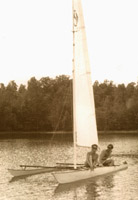 Consequently, he began to draw designs based on that odd-looking
catamaran---the word is from Sri Lanka, meaning "to lash two
trees together"--- and began building the first of many
experimental boats in 1957 while attending the University of North
Carolina at Chapel Hill in pursuit of a degree in Geography and
Geology. With that degree in hand in 1960, he realized that the only
livelihood available through applied paleontology was teaching. A
career in the classroom had zero appeal for Frank.
Consequently, he began to draw designs based on that odd-looking
catamaran---the word is from Sri Lanka, meaning "to lash two
trees together"--- and began building the first of many
experimental boats in 1957 while attending the University of North
Carolina at Chapel Hill in pursuit of a degree in Geography and
Geology. With that degree in hand in 1960, he realized that the only
livelihood available through applied paleontology was teaching. A
career in the classroom had zero appeal for Frank.
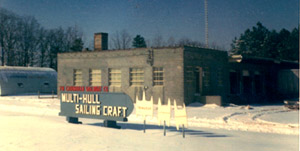 Evicted from the South Mangum Street shop by urban renewal
enforcers, Frank moved into a Quonset hut on the site now occupied
by the Auto Zone on Hillsborough Road in Durham and for brief period
took on as a partner Homer Athas, the brother of Chapel Hill
novelist Daphne Athas. "But Homer had the wanderlust,"
Frank recalls, and he soon moved on.
Evicted from the South Mangum Street shop by urban renewal
enforcers, Frank moved into a Quonset hut on the site now occupied
by the Auto Zone on Hillsborough Road in Durham and for brief period
took on as a partner Homer Athas, the brother of Chapel Hill
novelist Daphne Athas. "But Homer had the wanderlust,"
Frank recalls, and he soon moved on.
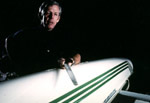 "When I designed my boat, " Frank says, "my goal was
not to build all kinds of boats. I was after a class boat, class
meaning something like the Thistle, the boat used to establish the
Portsmouth handicap system, which is a boat still sailing today.
That's the reason I only built two lengths, 14-foot and
16-foot."
"When I designed my boat, " Frank says, "my goal was
not to build all kinds of boats. I was after a class boat, class
meaning something like the Thistle, the boat used to establish the
Portsmouth handicap system, which is a boat still sailing today.
That's the reason I only built two lengths, 14-foot and
16-foot."
 To fill out those winter months, Frank took on contract jobs from
individuals and companies, reproducing in fiberglass anything a
customer could design or describe. He made 300-500-gallon
To fill out those winter months, Frank took on contract jobs from
individuals and companies, reproducing in fiberglass anything a
customer could design or describe. He made 300-500-gallon
 As general manager of IFG, Rhoda is steering efforts to increase the
output of Frank's cats. IFG sold rights to an Indonesian firm to
build and sell the boat in that region of the world. Rhoda is
advertising in the Commerce News Daily, a publication subscribed to
by all embassies in the United States, She hopes to build and
international market for the cats. If successful, she and Frank will
accompany shipments overseas and assist in organizing sailing
socials and regattas.
As general manager of IFG, Rhoda is steering efforts to increase the
output of Frank's cats. IFG sold rights to an Indonesian firm to
build and sell the boat in that region of the world. Rhoda is
advertising in the Commerce News Daily, a publication subscribed to
by all embassies in the United States, She hopes to build and
international market for the cats. If successful, she and Frank will
accompany shipments overseas and assist in organizing sailing
socials and regattas.
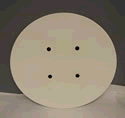 IFG has been very busy since the last update, holding the
IFG has been very busy since the last update, holding the

